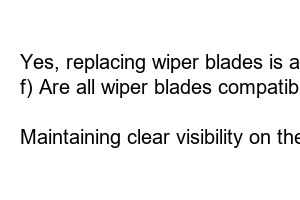와이퍼 교체 주기
Title: Maximizing Visibility: Understanding the Wiper Replacement Cycle
Introduction:
Driving in adverse weather conditions can be daunting, with rain, snow, and fog significantly hindering visibility. Luckily, wiper blades are designed to keep our windshields clear and provide a safer driving experience. However, like any other vehicle component, wiper blades wear out over time and require replacement. In this blog post, we will delve into the wiper replacement cycle and highlight everything you need to know to maintain optimal visibility on the road.
1. The Lifespan of Wiper Blades:
Wiper blades typically last between six months to a year, depending on various factors such as usage, weather conditions, and the quality of the blades. Frequent exposure to sunlight and harsh weather can speed up the deterioration process. Regular inspection is crucial as worn-out wiper blades compromise visibility and can result in accidents.
2. Signs of Worn-Out Wiper Blades:
It is essential to recognize the signs indicating your wiper blades need replacement. If you notice streaks, smearing, skipping, or a chattering noise during operation, it is likely time to install new wiper blades. Ignoring these signs can lead to reduced visibility, obstructed windshields, and potential accidents.
3. Proper Maintenance to Extend the Lifespan:
To prolong the longevity of your wiper blades, practicing regular maintenance is crucial. Clean the blades regularly, especially during the winter months when ice and snow can accumulate on them. Avoid using the wipers to remove heavy debris from the windshield, as this can damage the blades. Instead, clear the debris manually before operating the wipers.
4. Choosing the Right Wiper Blades:
When it comes to selecting replacement wiper blades, it is essential to ensure compatibility with your vehicle’s make and model. Opt for high-quality blades that provide excellent performance, durability, and streak-free wiping. Consulting your vehicle’s owner’s manual or seeking advice from a professional can help you make an informed decision.
5. The Wiper Replacement Process:
Replacing wiper blades is a simple task that can be done at home without the need for professional assistance. Start by lifting the wiper arm away from the windshield, then locate the release mechanism and press it to remove the old blade. Attach the new blade by aligning the adapter with the wiper arm, and secure it in place. Finally, gently lower the wiper arm back onto the windshield.
6. Frequently Asked Questions:
a) How often should I replace my wiper blades?
Wiper blades should be replaced every six months to a year, depending on various factors like weather conditions and usage.
b) Can I replace only the rubber strip instead of the entire blade?
While it is possible to replace just the rubber strip, it is generally more cost-effective to replace the entire blade as the rubber strip and frame wear down simultaneously.
c) Should I replace both wiper blades simultaneously?
It is recommended to replace both wiper blades simultaneously to maintain consistent performance.
d) Can I extend the lifespan of my wiper blades through cleaning?
Regular cleaning can help prolong the lifespan of wiper blades. However, worn-out blades will eventually require replacement.
e) Can I install wiper blades myself?
Yes, replacing wiper blades is a relatively simple task that can be done at home without professional assistance.
f) Are all wiper blades compatible with every vehicle?
No, it is crucial to select wiper blades that are compatible with your specific vehicle’s make and model for optimal performance.
Summary:
Maintaining clear visibility on the road is crucial for safe driving. Understanding the wiper replacement cycle, recognizing signs of wear, and practicing proper maintenance can ensure your wiper blades are functioning optimally. By selecting the right wiper blades and replacing them promptly when needed, you can experience uninterrupted visibility even in challenging weather conditions. Stay safe, and remember to keep an eye on your wiper blades to guarantee a safer and more enjoyable driving experience.

